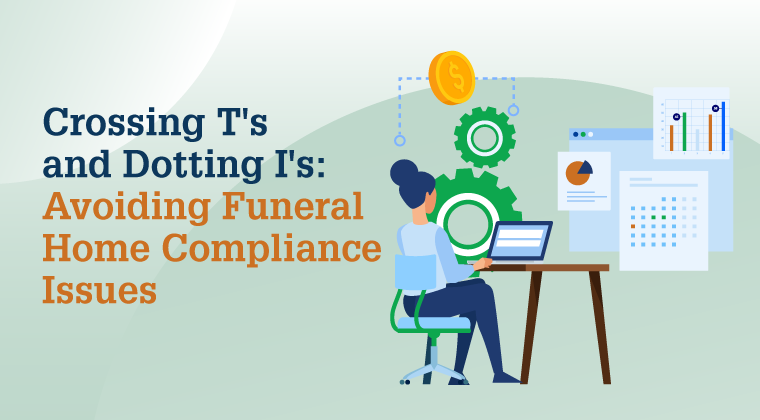When running a funeral home, your first priority will always be the families you serve; however, in order to do this safely, you’ll need to abide by Occupational Safety and Health Administration (OSHA) safety requirements for funeral homes.
By complying with federal guidelines you’ll protect both families and team members alike––not to mention avoid costly penalties.
OSHA Safety Requirements for Funeral Homes
Housed under the Department of Labor, the OSHA administers guidelines for workplace health and safety. While the organization enforces a number of guidelines that apply to all workplaces, they also have specialized standards and practices for death care businesses.
To ensure compliance with OSHA standards, funeral directors should mind the following:
Hazard Communication Standard
OSHA’s Hazard Communication Standard (29 CFR 1910.1200) requires all employers to identify and evaluate the presence of hazardous chemicals in the workplace. With regard to funeral homes, this means that they must:
- Provide a site-specific Hazard Communication Program to employees.
- Provide a comprehensive list of all hazardous chemicals used in the funeral home.
- Administer proper labeling and storage of said hazardous chemicals.
- Train the relevant employees about the hazardous chemicals with which they’ll come into contact.
Bloodborne Pathogens Standard
OSHA’s Bloodborne Pathogens Standard delineates safeguards that protect workers from contact with bloodborne pathogens. If your funeral home engages with embalming, then you must comply with this standard by:
- Writing an Exposure Control Plan, the aim of which is to eliminate employee exposure to bloodborne pathogens. This plan should be reviewed and updated yearly.
- Offering Hepatitis B vaccinations to all employees at risk of exposure.
- Regularly evaluating and documenting the current safety measures and implementing new commercially available tools accordingly.
- Implementing protocol for evaluation and action in the event of an employee’s exposure to blood or other infectious materials.
- Conducting regular disinfecting and sterilization of areas, surfaces, and instruments that may be contaminated with blood or other infectious materials.
- Properly labeling, storing, and/or disposing of biohazardous materials.
- Training relevant employees on safety procedures related to blood and other infectious materials.
Personal Protective Equipment Standard
OSHA’s Personal Protective Equipment (PPE) Standard (29 CFR 1910.132) requires employers to provide adequate protective equipment against any hazards of their roles. For funeral homes, this means that an employer must provide PPE such as coveralls, shoe covers, goggles, face shields, gloves, surgical masks, and head coverings, among others.
As well as providing the equipment, an employer must perform an initial assessment to determine the specific types of equipment that are necessary, as well as train each relevant employee on the proper use of said equipment.
Respiratory Protection Standard
OSHA’s Respiratory Protection Standard (29 CFR 1910.134) applies anywhere in the workplace where respirators are required. For funeral homes, this may mean roles in the preparation room.
Under this standard, funeral homes must:
- Create a written Respiratory Protection Program.
- Administer regular fit-testing of employees with their respirators.
- Provide annual training on the proper use of respirators.
Formaldehyde Standard
Often used in embalming practices, formaldehyde has its own specific regulations from OSHA (29 CFR 1910.1048). This standard sets maximum levels for workplace exposure and requires that funeral homes implement safeguards to protect workers from the negative effects of formaldehyde exposure.
Under this standard, funeral homes must measure exposure levels to formaldehyde during embalming, notify affected employees of monitoring results, implement training measures, and provide emergency equipment for sanitation.
Fire Extinguisher Training
While OSHA does not necessarily require fire extinguishers in funeral homes, having a fire extinguisher means you must abide by their Fire Extinguisher Training Standard (29 CFR 1910.157).
Under this standard, employers must:
- Properly mount, identify, and inspect fire extinguishers.
- Have a Safety Data Sheet available if the fire extinguisher is pressurized or contains hazardous chemicals.
- Inspect all fire extinguishers monthly.
- Train employees annually on the proper use of fire extinguishers.
Medical Services and First Aid Regulation
OSHA’s Medical Services and First Aid Regulation (29 CFR 1910.151) stipulates the following:
- If a clinic or hospital is not near one’s funeral home, then an employee must be adequately trained to render first aid, and they must be provided with adequate supplies to do so.
- A funeral home must supply and maintain eyewashes and drench showers that comply with current ANSI standards.
Walking and Working Surface Safety Standard
To protect workers from slips, trips, and falls, OSHA’s Walking and Working Surface Safety Standard (29 CFR 1910.21) outlines guidelines for basic safety in this regard. Under this guideline, employers must:
- Ensure that walkways are lit, contain non-slip surfaces, and are free from obstructions.
- Clean up spills quickly and display warning signs as needed.
- Encourage employees to avoid steps and stairs while moving loads.
- Properly cover and repair any openings or holes in flooring.
Avoiding Citations and Penalties
While the severity of OSHA penalties varies, fines for failure to meet OSHA standards can cost you anywhere from $1,036-$14,502. And while OSHA clearly lays out each of its safety standards online, understanding and implementing them can be a complicated process, one that requires the help of experts. This is where hiring a consultant can help.
At Johnson Consulting Group, our team of death care consultants has decades of experience helping funeral homes implement and abide by OSHA safety standards. With our assistance, we can train your team members in the appropriate safety techniques to keep your business and your employees safe.
AVOID COMPLIANCE ISSUES